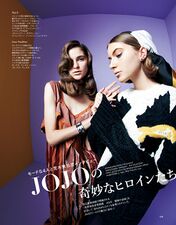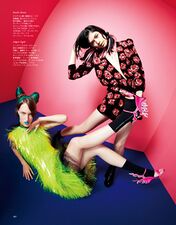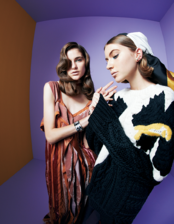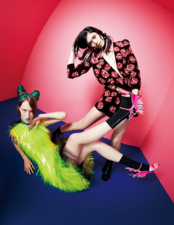SPUR Magazine (August 2018)
Araki's Motivation (August 2018)
Interview Archive
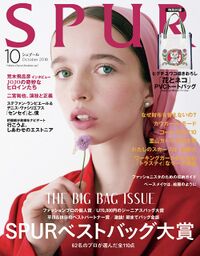
Interview with Hirohiko Araki in the October 2018 issue of SPUR magazine, published on August 23, 2018.[1] The interview was also posted on SPUR's official website on September 9, 2018.[2]
Interview
Interview with Hirohiko Araki! -- Behind the Heroines of "30 Years of JoJo"
The female characters in the manga JoJo's Bizarre Adventure are what makes it so interesting!
"They're so stylish that it's almost out of this world."
With the theme this time being "JoJo's Bizarre Heroines", I'd like to explore the charms of female characters appear in the JoJo series. Is there anything that worries or concerns you when you draw female characters?
No, not really. I don’t distinguish between men and women like that. When it comes down to it I think I’m more concerned about whether I make them stylish or cute. I’m not very good at the “cute” part, so I often focus on drawing them stylish instead.
The definition of stylish is pretty broad, but in my opinion, it’s someone who’s a loner. Although society doesn’t recognize them, they’re still able to maintain a strong sense of justice. That’s what makes a hero/heroine. They’re so stylish that it’s almost out of this world.
On the previous page, there’s a photo shoot with the likes of four of your female characters, Erina, Suzi Q, Jolyne, and Yasuho. If you could best describe each of these characters with a single word, what would it be?
If I were to contrast these four, Erina would obviously be the most honest, Suzi Q would be joyful and a bit ditzy, Jolyne would stand out as tough and hardy, and Yasuho would be the most modern of the bunch.
Which of these characters do you have the most fondness for?
From these few, I’d have to say Yasuho, since I like drawing her the most. I never get sick of drawing Yasuho, which is why I like her. (Laughs)
But, what about Jolyne? She was the first female protagonist in the series.
Of course, I’ll always have a place in my heart for Jolyne. It was thanks to her that I was finally able to depict violent scenes, such as women getting punched in the face, and people having their arms cut off. Prior to then, that wasn’t something I could easily get away with.
Before JoJo, I drew Gorgeous Irene (1985), a series that also featured a female main protagonist. Nowadays, there’s a lot of works that feature women fighting, but back then that wasn’t something possible to do in a shonen magazine. So, I gave up on it and decided not to make it a full-length series.
Even though it was your own work, did you ever feel uncomfortable drawing a female protagonist?
I couldn’t draw action scenes at all. It was around the same time “Aliens” was released, and I liked Sigourney Weaver‘s performance as Ripley. I thought she was so strong and cool, and I wanted to portray something like that in my manga. However, I thought drawing a girl getting beat up was far too cruel.
Back then, I couldn’t draw thin eyebrows either. In those days, it was the norm for heroes in shonen magazines to have big thick eyebrows. Characters with thin eyebrows would often end up looking like villains. It was far too early to have a female protagonist in a shonen magazine. This was still the heyday of Stallone and Schwarzenegger. (Laughs)
However, fast forward 15 years, and now the times have changed. Now it’s okay to draw a scene of a girl taking punches. By then, I thought it was time that I could properly draw a tough female protagonist, and so I decided to make Jolyne the main character for Part 6.
"Depicting fiction through fashion…"
For instance, when drawing female characters, do you start from the eyes, or is there a different process than that of drawing male characters?
There is no specific difference in the way I draw male and female characters. Rather, I like to use women’s poses as a reference when drawing. So I often end up drawing male characters by looking at the models in women’s fashion magazines.
Most of the time, the models in men’s fashion just stand around, while the models in women’s fashion are always doing interesting poses, like twisting their hips or bending their necks. It’s always interesting to the various ways in which they pose. The contours and skeletal structure of the models are obviously taken from different sources, but when it comes to posing, there is no difference between male and female characters. Both are usually drawn using women’s fashion magazines as a reference.
Then, how about fashion? Is there a big difference in fashion when you draw male and female characters?
That’s right. In terms of fashion, I think there’s a major difference between men and women. When I think up a character, I create kind of a portfolio for them. There are about 60 boxes in total, and by adding various details about them, such as their personality, habits, favorite foods, etc., the character becomes more and more three-dimensional and fleshed out, just like a real person.
When thinking about what to add, I rarely ever take into consideration whether they’re a man or woman, but I can’t help but notice the differences in fashion.
The fashion in JoJo has received a great deal of attention from readers. The flowers on Yasuho’s skirt, the thick chain on Jotaro’s school uniform, how did you come up with these creative details?
When looking for references, I often find myself taking inspiration from fashion magazines and such. Putting chains on a character’s clothing is, in essence, something that only exists in fiction. Obviously, you can’t go putting a chain on your school uniform. But, by doing so, it creates a suspension of disbelief and lets the reader know that they’re reading a manga. The same applies to the flowers on the skirt.
The fact that I can do this in a way that’s easy to understand is the reason why fashion is so interesting to draw.
"Women are goddesses. They make the world a happier place…"
Do you have an ideal heroine in mind?
Ideally, it would have to be someone who is determined to achieve their goals, and also, be someone who is kind and caring. But, it’s okay if they’re a little crude from time to time. (Laughs)
I can never forgive the vulgar side of men, but if it’s a woman, I think I can let it slide. It makes me wonder if there’s a reason why. Given the current situation, I think there’s a lot more sympathy towards characters with flaws and imperfections than for those who are too well-mannered. For example, I think Yasuho, who is a bit troubled, will be a lot more interesting than Erina, who is like the Virgin Mary.
Araki-sensei, this might be a vague question, but what does a woman mean to you?
A goddess. One that makes the world a happier place. Is that wrong? (Laughs)
No, not at all. (Laughs)
However, that doesn’t mean that I worship them excessively. But, they are goddesses in the sense that you have to treat them with proper manners and respect. So I guess it’s similar to the phrase “ladies first”.
That’s why I try to put women before me whenever something goes wrong unless it’s something serious. Most things go well in life when you live thinking of women as goddesses. At least, that’s how it is in my family. (Laughs)
Is it okay to have a vulgar side, even if you’re a goddess?
It’s okay. I mean, the women in Greek mythology are scary. (Laughs)
Zeus’s wife is very angry and jealous, isn’t she? But I think that’s what makes the story interesting. So I think it’s better to have a vulgar side. (Laughs)
[Translated by Morganstedmanms (JoJo's Bizarre Encyclopedia)][3]
荒木飛呂彦インタビュー! JOJO30年のヒロインの裏側
ちょっと世の中からはみ出ているところがかっこいい
―― 今回は「JOJOの奇妙なヒロインたち」というテーマで、『ジョジョ』シリーズにおける女性キャラクターの魅力などについてお話を伺っていきたいと思います。荒木さんが女性キャラクターを描くにあたって、何か意識していることやこだわっていることはあるのですか?
荒木 特にないんですよね。女性だからとか、男性だからとか、そういった形では区別していなくて、しいて言えば、可愛いか、かっこいいかぐらいの意識の違いかな。ただ、僕はいわゆる可愛いがあまり得意じゃないから、どうしてもかっこよさを意識して描くことが多いですね。かっこいいといっても、そこにはいろいろな定義があって、僕の場合はまず孤独であることだと思っています。社会から認められていないけれど、自分の信じる正義を貫いている。それがヒーローであり、ヒロインなんですよ。ちょっと世の中からはみ出ているところがかっこいいんです。
―― 前のページで、エリナ、スージーQ、徐倫、康穂の4名の女性キャラクターをイメージしてファッションシューティングを行なっているのですが、それぞれのキャラクターをひと言で表現するとしたらどんな感じになりますか?
荒木 この4人を対比させるのであれば、エリナはやっぱり誠実で、スージーQは明るくておっちょこちょいで、徐倫はポップではつらつとしていて、康穂はいちばん現代的な子という感じですかね。
―― この中でいちばん思い入れがあるのは誰ですか?
荒木 僕は今描いているのがいちばん好きなので、この中だと康穂ですね。康穂ってちょっと病んでいる感じがあって、それが何かいいんですよ(笑)。
―― 徐倫はどうですか?『ジョジョ』シリーズで初めての女性の主人公でした。
荒木 もちろん、思い入れはあります。女性にパンチを食らわしたり、腕を切られたり、そういうバイオレンス描写ができるようになったのはやっぱり徐倫からなので。それまではなかなかできなかったですからね。『ジョジョ』を描く前に、『ゴージャス☆アイリン』(,85 年)という女性が主人公の作品を描いたことがあるんですよ。今でこそ女性が戦う作品はたくさんありますけど、当時の少年誌ではあり得なくて、描いていて気持ち悪くなるし、「これはダメだ」と思って長編にするのをやめました。
―― 自分の作品なのに、描いていて気持ち悪くなったんですか?
荒木 アクションシーンを描くのがダメでしたね。当時は『エイリアン2』が公開された頃で、シガニー・ウィーバー演じるリプリーが強い女性でかっこいいなと思ったから、僕もマンガでトライしてみたんだけど、やっぱり女の子が殴られたりするのはちょっと残酷すぎて描けませんでした。それに、当時は細い眉も描けなかったんですよ。あの頃の少年誌の男の主人公はみんな眉が太くて、それが普通だったので、細い眉のキャラクターって何か悪役に見えてくるんですよね。そういう時代だったから、少年誌で女性の主人公を描くのはまだ早かった。まだスタローンとシュワルツェネッガーの時代だったんですよ(笑)。ただ、それから15年近くたつと時代も変わって、女の子がパンチを食らったりするシーンを描いても平気な感じになった。これならちゃんとタフな女の子が描けると思って、第6部は徐倫を主人公にしたんです。
ファッションでファンタジーを表現する
―― たとえば、女性キャラクターを描くときは目から描き始めるとか、男性キャラクターのときと手順が違ったりするのですか?
荒木 そういった描き方の違いも特にないですね。というより、絵を描くときは基本的に女性のポージングを参考にして描いています。なので、男性のキャラクターも女性ファッション誌に登場するモデルとかを見ながら描いているんですよ。男性ファッション誌のモデルはただ立っているだけというのが多いんですけど、女性誌のモデルは腰をぐっとひねったり、首をぐいっと曲げたり、ポージングがいろいろあって面白いんですよね。輪郭とか骨格みたいなところはさすがにそれぞれ別のものを参考にしますが、ポージングに関しては男と女のキャラクターで違いはなくて、どちらもだいたい女性ファッション誌を参考にして描いています。
―― では、ファッションはいかがでしょう。男女のキャラクターを描くうえで、ファッションの違いは大きいですか?
荒木 そうですね。男女で大きく違ってくるのは、ファッションの部分だと思います。僕は、キャラクターを考えるときは身上調査書みたいなものをつくるんですよ。全部で60項目ぐらいあるんですけど、性格とか口癖とか好きな食べ物とか、いろいろと細かく設定していくことで、キャラクターがどんどん立体的になっていくというか、実在の人物のように生き生きしてくるんです。そうやって設定を考えるときでも、ほとんど男とか女ということは意識しないのですが、やっぱりファッションだけはどうしても違いが出てきますね。
――『ジョジョ』シリーズのファッションは、読者からの注目度も非常に高いです。康穂のスカートについている花だったり、承太郎の学ランについている太いチェーンだったり、ああいう独創的なディテールはどうやって生まれるのですか?
荒木 ファッション誌とかを見て、参考にすることが多いですね。チェーンをつけたりするのは、要するにファンタジーなんですよ。学生服にチェーンをつけることってまずないじゃないですか。だから、そうすることで、ファンタジーになっていくというか、「これはマンガなんです」ってことを表現しているんです。スカートに花がたくさんついているのもそう。それがわかりやすくできるところが、ファッションを描いていて面白い部分ですね。
女性は女神。世の中を幸せにする存在
―― 理想のヒロイン像というのはあったりするのですか?
荒木 目的に向かって強い意志を持っていて、そのうえでどこかにやさしさがあるというのが理想ですよね。あとは、ちょっとゲスな部分があるのもいいかな(笑)。男のゲスな部分は許せないけど、女性のゲスな部分は許せます。その背景に何か理由があるのかなって思っちゃうんですよね。今の時代状況を考えると、品行方正なキャラクターよりも、どこかに欠点があったり、悩みを抱えているキャラクターのほうが読んでいて共感する部分が多いと思います。聖母マリアみたいなエリナよりも、ちょっと病んだ感じの康穂のほうが間違いなく面白くなるんだろうなって。
―― 漠然とした質問になりますけど、荒木さんにとって女性とはいったいどういう存在ですか?
荒木 女神ですね。世の中を幸せにする存在。ダメですかね(笑)。
―― ダメではないですよ(笑)。
荒木 だからといって、過剰に崇め奉るということではなく、マナーを守り、きちんと敬意をもって接するという意味合いでの女神なので、レディファーストみたいな考え方に近いのかな。だから、何かもめ事が起きたときも、よほどのことがない限り、女性を上に置くようにしています。女性という存在を女神だと思って生活していると、大抵のことはうまくいくんです。少なくとも、わが家はそうですね(笑)。
―― 女神なのに、ゲスな部分があってもいいんですか?
荒木 いいんです。だって、ギリシャ神話に登場する女性たちはヤバいじゃないですか(笑)。ゼウスの奥さんとか、ものすごく怒るし、嫉妬深いですよね。でも、そういうところが話を面白くしていると思うので、ゲスな部分ってやっぱりあったほうがいいんですよ(笑)。
